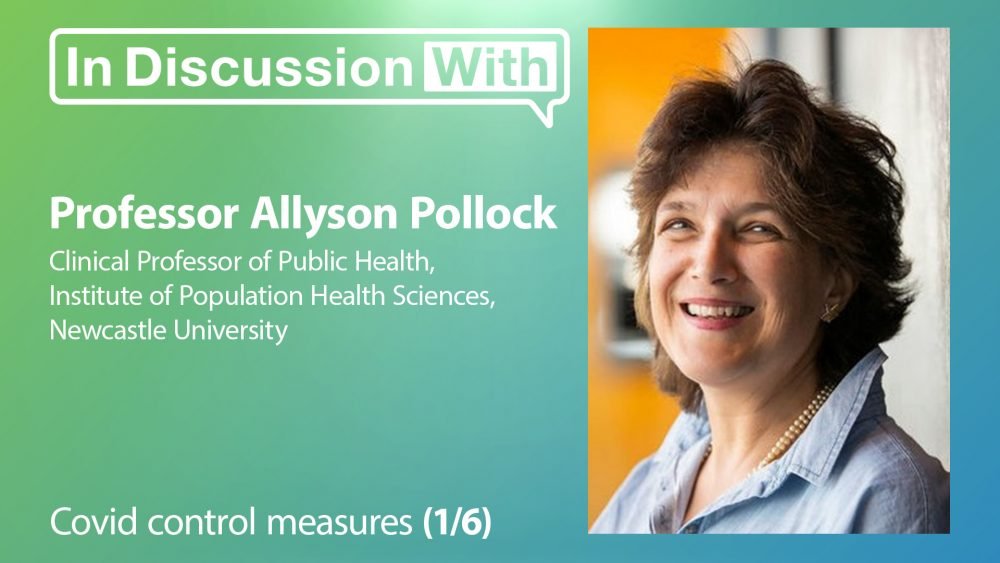Advertisment
Evidence-based public health: Covid control measures

As the coronavirus pandemic appears to be running out of steam it is important to review the lessons learned and move forward to ‘living with the virus’. IMI spoke to Allyson Pollock, Clinical Professor of Public Health at Newcastle University to find out more.
The important thing to understand about endemicity is the virus never goes away – doesn’t ever disappear completely”, says Professor Pollock. There will continue to be outbreaks of disease and the severity and frequency will depend on how much population immunity has been established. The common cold and influenza are seasonal viruses that circulate more commonly in wintertime, causing intermittent outbreaks. “Sometimes the ‘flu outbreaks will be less serious and sometimes they’ll become epidemic because there’s not enough population immunity”, she says. Covid-19, which is a coronavirus like the common cold, can be expected to behave in a similar way.
Some people are more susceptible to covid-19 than others. “We knew right away from the Chinese experience that those who were most at risk were those in the older age groups, …. with risk …. increasing or doubling every decade over the age of 60. We also knew that children were far less at risk – it was a far less severe disease in children – so we knew this very early on”, says Professor Pollock. “What we now know from the data in hospitals is that …. poverty is a very bad indicator for bad outcome and of course poverty is associated with co-morbidities”, she continues. Obesity is another independent risk factor, although it can also be linked to poverty. “So, we know that poverty is a major risk factor – whether you’re vaccinated or unvaccinated – for worse outcomes and that’s associated also with comorbidities such as asthma, diabetes and also obesity in its own right”, she says.
Professor Pollock says we may never know how effective the control measures – non-pharmaceutical interventions – for pandemic control are. Hand hygiene remains important but “what we still have is very weak, uncertain, unknown evidence around … the effect of the isolation, social distancing – the two-meter rule – but also masking in community and especially in school settings”, she says. The necessary studies have not been performed and we have been left with strong beliefs and opinions “in both directions around masks but very, very weak and uncertain evidence both for and against”.
“If we look at masking, one of the reasons, of course, is [that] the theory may be very different from the practice. So, in theory you may think that masks would be a good thing but actually if you look at the practice …… most of us, unless you have quite obsessive-compulsive tendencies – don’t actually wear our masks terribly well. … We really still have a huge amount of uncertainty and unknowns but there’s been an enormously strong lobby, lobbying for masks and the Government adopted it probably because they needed to be seen to be doing things”, says Professor Pollock
Moreover, “once you start to adopt these mass interventions you are distracting from the real issues that we know are important. So, we knew that the most at-risk group were people who were older, people in vulnerable settings, vulnerable people in nursing homes, residential care homes but also people who were poor. So, what’s happened is we’ve spent billions of pounds on masks and PPE in community settings and school settings and workplaces, creating huge waste environmentally. But actually, if we had really thought about it hard, we might well have diverted those resources into what we do know works, which is alleviating poverty, alleviating stress of illness and also increasing the capacity in social care, residential homes and nursing homes”. The real problem in these settings was not the lack of non-pharmaceutical interventions, but lack of staffing and lack of health care input. Understaffing and poor pay remains a problem in our nursing homes, in residential care and social care. The billions of pounds that were spent on PPE and other measures could have been diverted into funding for this sector, she suggests. “The quality and outcomes of care are directly related to the quality and number of staff that you have in nursing homes, social care and environments where [there are] vulnerable groups in institutional settings”, she says.
Read and watch the full series on our website.





